About Udaipur
Udaipur is the most beautiful travel destination of Rajasthan. It is famous for its cultural heritage, amazing nature settings, lovely lakes and stunning palaces. Udaipur is the capital of the Mewar Kingdom (former princely state). A current tourist favorite, especially for up-market Westerners, it was a backdrop for numerous movies including the James Bond flick "Octopussy".
Udaipur is referred to as the "Venice of the East", the "Most Romantic City of India" and the "Kashmir of Rajasthan" (a reference to Dal Lake) and not without reason. Tourists flock to this enchanting old & modern town in the heart of the Aravalli Mountains, which offers three interconnected lakes within the town - the Fateh Sagar Lake, the Lake Pichhola and the smaller Swaroop Sagar Lake; along with forts, palaces, temples, gardens, mountains and narrow lanes lines withdrawn with stalls, relives the reminisces of a heroic past, valor and chivalry.
Udaipur receives ample number of tourists from all over the world every year. The city is still inhabited by people of Bhil tribe. Udaipur dwellers are really friendly and good to be with. On your first look, you will find them rugged, but these people are really good at heart. Untouched by the pace of modern times, these desert people are well-built, simple and cheerful. Here, people usually prefer wearing bright colored clothes. Colorful festivals and fairs depict the cultural prosperity of Udaipur.
The climate of Udaipur is tropical, with the mercury staying between a maximum of 42.3°C and a minimum of 28.8°C during summers. Winters are mild with the maximum temperature rising to 28.8°C and the minimum dipping to 2.5°C. Best time to visit is during the winters preferably September to March.
HOW TO REACH UDAIPUR
Udaipur is easily accessible from every major destinations of India. The city is well connected with Agra 630km, Delhi 670km, Mumbai (formerly Bombay) 739km, Ahmedabad 260km, Ajmer 265km, Chittorgarh 115km, Jaipur 405km and Jodhpur by 275km.
By Air Dabok airport, also known as Maharana Pratap Airport, is 24km from the city centre.There are daily flights from Delhi, Mumbai and Jaipur on Jet Airways, Indian Airlines, Air Deccan, and Kingfisher Airlines. You pre-pay for the taxi inside the airport. Come prepared with cash since they don't take credit cards and there is no ATM at the airport.
By Train Train service has improved over the last few years after Udaipur was converted to broad gauge railway line. There are now daily trains from New Delhi, Mumbai, Ahmedabad and Jaipur. If you coming from Western or Southern India, take a train to Mumbai and then an overnight train to Udaipur. Alternatively, you can take a train to Ahmedabad and then, travel by any express train that leaves in the evening for Udaipur for an overnight journey.
By Bus Udaipur is connected by an efficient bus service with most Rajasthani towns including Jaipur, Jodhpur, Bikaner, Ajmer, Mount Abu. Buses also head south to Ahmedabad with connections to Mumbai but it is not a short journey. There are comfortable sleeper coaches available for longer trips. The city lies on the Golden Quadrilateral, midway between Delhi and Mumbai National Highway (NH) 8; it is around 700km from either metro. The roads in this part of the country are paved and fit for private vehicles. State Transport Authorities and private tour agents operates daily buses between Udaipur-Jaipur, Udaipur-Delhi, Udaipur-Ahmedbad, Udaipur-Jodhpur. Some of these buses also have sleeper coaches for a comfortable journey.
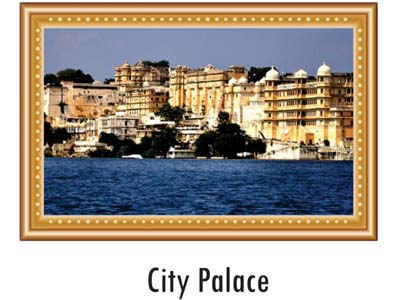

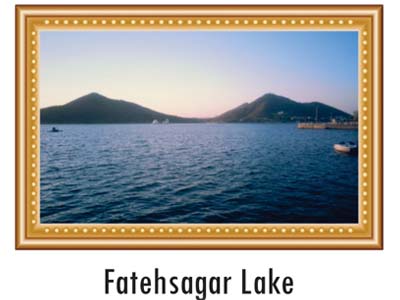
PLACES TO SEE
Udaipur City Palace
The splendid City Palace, posing over the fascinating Lake Pichola, is one of the most beautiful palatial structures. The elegant palace originally built by Mahrana Uday Singh II rises 30 meters above Lake Pichola and extends up to 244 meters. The City Palace of Udaipur has number of small and big palaces, museums and the gardens. There are many popular palaces inside the City Palace Complex. The unique aspect of this conglomeration is that the architectural design (a rich blend of Rajasthani, Mughal, Medieval, European and Chinese Architecture) is distinctly homogeneous and eye catching.
The palace complex has been built entirely in granite and marble. The interiors of the palace complex with its balconies, towers and cupolas exhibit delicate mirror-work, marble-work, murals, wall paintings, silver-work, inlay-work and leftover of colored glass. The complex provides a fine view of the lake and the Udaipur city from its upper terraces.
Key destinations in City Palace
Jagadish Temple -
Located 150m north of the palace in Indo-Aryan architectural style, the temple is dedicated to Lord Vishnu. The temple walls and the shikara or tower are decorated with carvings of Vishnu, scenes from Lord Krishna’s life and figurines of nymphs or apsaras. The street square, where the temple is located, is also known as Jagdish Chowk from where several roads radiate in different directions.
Krishna Vilas - Another chamber in Fatehprakash Palance with rich collection of miniature paintings that portray royal processions, festivals and games of the Maharanas. However, there is tragic story linked to this wing of the City Palace. In the nineteenth century, a royal princess was unable to choose from two suitors seeking her hand in marriage, one from the royal family of Jaipur and another from Jodhpur, and hence in a state of dilemma, she poisoned herself to death.
Fateh Sagar Lake -
An artificial lake constructed by Maharana in north of Lake Pichola in 1678 and to the north-west of Udaipur. Within the confines of the Fateh Sagar Lake, there are three small islands.; the largest of these is called the Nehru Park, the second island houses a public park with an impressive water-jet fountain and the third island is the address for the Udaipur Solar Observatory. Every year a festival called the Hariyali Amavasya Mela (Green New Moon Fair) is organized at the lake precincts,in the month of August/September.
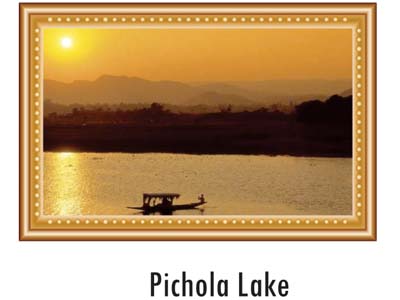
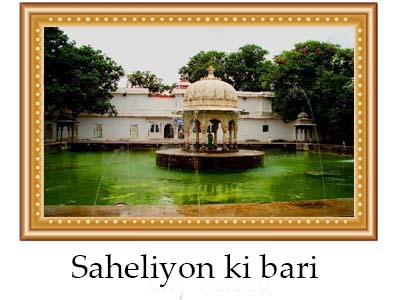

Pichola Lake -
An artificial fresh water lake, created in the year 1362 AD, named after the nearby Picholi village. The lake’s surroundings and the several islands within the lake have been developed over the centuries, with palaces, marble temples, family mansions, and bathing ghats. The famous Lake Palace (now converted into a heritage hotel) is located in the middle of the lake. Two islands, Jag Niwas and Jag Mandir are located within Pichola Lake. Local buses, Tongas, auto-rickshaws and taxis provide the needed transport.
Saheliyon ki Badi -
Built by Maharana Bhopal Singh. Saheliyon ki Bari means Garden of the Maids. This garden area lies in northern part of the city and has fountains and kiosks, a lotus pool and marble elephants. Each water channel has its distinct sound and the mingling of these sounds complement the ambience of the place. There is also a small museum here. Sahelion Ki Bari' was laid for a group of forty-eight young women attendants who accompanied a princess to Udaipur as part of her dowry.
Sukhadia Circle -
A large roundabout in the city's northern suburb of Panchwati, on the road to Ranakpur and Mt. Abu. centrepiece of the Circle is a large, three-tiered fountain just over 21 m. high, with scalloped dishes surmounted by a wheat-ear motif, representing prosperity. Illuminated at night, it is now a well-known landmark.
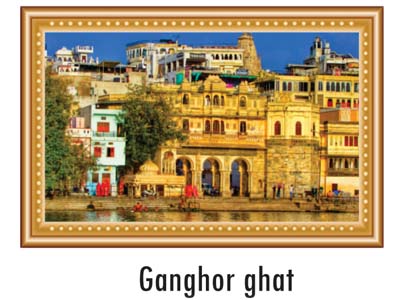


Udaipur Solar Observatory -
Located on an island in the Fateh Sagar Lake, the observatory is claimed to be one of the Asia's largest. The observatory was built in the year 1976 by Dr. Arvind Bhatanagar following the model of the Solar Observatory at Big Bear lake in Southern California.
Gulab Bagh and Zoo -
A rose garden laid out by Maharaja Sajjan Singh is situated near the palace on the east side of Lake Pichhola. A library in the garden has a collection of ancient handwritten manuscripts and books. Within the garden, there is a zoo with tigers, leopards, chinkara gazelle, birds, and many wild animals. Children can enjoy mini train, track of which covers the main part of the garden and the zoo.
Doodh Talai -
A rock and fountain garden and the sunset point from which one can enjoy the sunset view in Lake Pichhola and a panoramic view of the old city. Also one can enjoy the Aerial tramway (rope way) which connects one of the dudh talai gardens to Karni Mata temple.
Nehru Garden -
This is a park situated in the middle of Fateh Sager Lake. This park covers about 41 acres (170,000 m2), with flower gardens and a lily pond. It was inaugurated on the birth anniversary of the first Prime Minister of India, Jawaharlal Nehru. The garden overlooks the ancient Moti Mahal of Maharana Pratap and gives a view of the Aravalli hills on three sides.
Bagore-ki-Haveli -
An old building built right on the waterfront of Lake Pichola at Gangori Ghat. Amir Chand Badwa, the Prime Minister of Mewar, built it in the eighteenth century. The palace has over a hundred rooms, with displays of costumes and modern art. The building has a large and exquisite collection of Mewar painting and glassworks.
Ahar Museum - The Ahar Cenotaphs are a group of royal cenotaphs located in Ahar, about 2km east of Udaipur. The site contains more than 250 cenotaphs of the maharajas of Mewar that were built over approximately 350 years. There are 19 chhatris that commemorate the 19 maharajas who were cremated here.
Aapni Dhani - A very good place to spend your evening. This place has a small zoo, magic show, puppet show, nat ka tamasha, dance shows and to top it all a nice Rajasthani dinner - unlimited of course. The ticket is about Rs 250 per person. The shows start in the evening around 5-6 pm.
Excursions
Udaipur offers great excursions to its outskirts. Hire a cab or explore by yourself to the some of the great escapades on the city outskirts. Eklingji Temple - 22km north of Udaipur is one of the most famous temples of Rajasthan. The magnificent architecture of Eklingnath Temple is simply remarkable.
Haldighati -
An important historical site in the context of Rajasthan at a comfortable distance of 40 kms from the city of Udaipur. The term Haldighati has been derived from the yellow colored soil of the place that gives a sense of turmeric (in Hindi).
Jagat Temple -
Being located at the village called Jagat, at a distance of 58kms in the south-east of Udaipur. Built in 961 A.D, the Jagat Temple is renowned for its intricate carvings in the exteriors.
Kankroli -
A small town, located at a distance of 65 kms from the city of Udaipur mainly known for its temple, which is sited on the banks of renowned Rajsamand Lake.
Nagda -
Located besides Bagela Lake at a distance of 23 kms in the north-west of Udaipur on the way to Nathdwara. Nagda comprises many small and big temples, but the main attraction is gained by its 'Sas-Bahu' temple.


